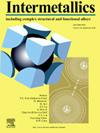制备方法对非晶Zr35Ti30Be27.5Cu7.5合金性能的影响
IF 4.3
2区 材料科学
Q2 CHEMISTRY, PHYSICAL
引用次数: 0
摘要
锆基大块金属玻璃,如Zr35Ti30Be27.5Cu7.5,具有出色的强度,弹性和耐腐蚀性,使其在高级工程应用中具有很高的吸引力。然而,由于防止结晶所需的高冷却速率,生产大块非晶元件仍然具有挑战性。采用铸造、连接片材、直接能量沉积、粉末床熔炼等方法制备Zr35Ti30Be27.5Cu7.5合金。对比分析了它们的结构、相组成、密度和力学性能,揭示了所用方法的主要特点。由于铸锭中心冷却不足以及缺陷,铸件存在结构不均匀和密度低的问题。连接板材材料产生小而均匀的非晶态区域(< 5mm),但由于温度控制问题,在密度和可扩展性方面面临挑战。直接能量沉积可以产生更大的致密体(>;10毫米),具有高非晶性和密度;然而,不均匀的晶体分布降低了机械性能。粉末床熔融技术是生产高质量、高强度和高密度锆基大块金属玻璃部件的最佳技术,在材料性能和制造精度方面都优于其他方法。确定了最佳工艺条件,为大规模制备性能优异的zr基块状非晶金属合金提供了途径。本文章由计算机程序翻译,如有差异,请以英文原文为准。
Impact of manufacturing method on the properties of bulk amorphous Zr35Ti30Be27.5Cu7.5 alloy
Zirconium-based bulk metallic glasses, such as Zr35Ti30Be27.5Cu7.5, exhibit outstanding strength, elasticity, and corrosion resistance, making them highly attractive for advanced engineering applications. However, producing bulk amorphous components remains challenging due to the high cooling rates required to prevent crystallization. In this study, Zr35Ti30Be27.5Cu7.5 alloys were fabricated using casting, joining sheet materials, direct energy deposition, and powder bed fusion. Comparative analysis of their structure, phase composition, density, and mechanical properties revealed the main features of the methods used. Castings suffer from structural inhomogeneities and lower density due to insufficient cooling in the ingot center, as well as defects. Joining sheet materials produces small, homogeneous amorphous regions (<5 mm) but faces challenges regarding density and scalability due to temperature control issues. Direct energy deposition enables the creation of larger compacts (>10 mm) with high amorphism and density; however, non-uniform crystallite distribution reduces mechanical properties. Powder bed fusion emerges as the optimal technology for producing high-quality, high-strength, and high-density Zr-based bulk metallic glass components, outperforming other methods in both material properties and manufacturing precision. Optimal conditions were identified, providing a pathway for scalable manufacturing of Zr-based bulk amorphous metallic alloys with superior properties.
求助全文
通过发布文献求助,成功后即可免费获取论文全文。
去求助
来源期刊

Intermetallics
工程技术-材料科学:综合
CiteScore
7.80
自引率
9.10%
发文量
291
审稿时长
37 days
期刊介绍:
This journal is a platform for publishing innovative research and overviews for advancing our understanding of the structure, property, and functionality of complex metallic alloys, including intermetallics, metallic glasses, and high entropy alloys.
The journal reports the science and engineering of metallic materials in the following aspects:
Theories and experiments which address the relationship between property and structure in all length scales.
Physical modeling and numerical simulations which provide a comprehensive understanding of experimental observations.
Stimulated methodologies to characterize the structure and chemistry of materials that correlate the properties.
Technological applications resulting from the understanding of property-structure relationship in materials.
Novel and cutting-edge results warranting rapid communication.
The journal also publishes special issues on selected topics and overviews by invitation only.
 求助内容:
求助内容: 应助结果提醒方式:
应助结果提醒方式:


